.png)
INTRODUCTION
Professor @fendit took her time to explain to us Wyckoff's method of analyzing financial markets. The laws of demand and supply and fundamentals. The lecture came with the homework task as follows;
- Share your understanding of "Composite Man" and the fundamental laws. What's your point of view on them?
- Share a chart of any cryptocurrency of your choice (BTC or ETH won't be taken into account for this work) and analyze it by applying this method. Show clearly the different phases, how the volume changes, and give detail of what you're seeing.
This article is an attempt to complete the task successfully.
COMPOSITE MAN
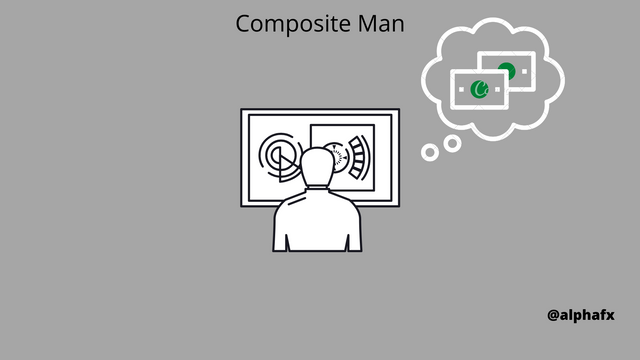.png)
Think of this, the financial markets are worth trillions of dollars. Even with $10,000, I do not makeup to 0.01% of the market, meanwhile there is someone out there with billions, enough to leave footprints for each move he makes in the market. Now imagine that same person deciding to leave misleading footprints, to his own gain and the loss of late investors, Wyckoff refers to this person as the COMPOSITE MAN.
The Composite Man according to Wyckoff is an investor who slowly bought a lot of stocks in a particular commodity. He does this slowly so that there would be no major move in the market. When he is done buying up, he starts spreading the "good news" of this commodity to everyone, trying to get them to buy, while doing this, he could make a major buy, to trigger a small market move that convinces people to buy.
While people buy, he prepares to sell, and when the time comes, he starts selling off his goods slowly to the people joining the hype. When he is done, the supply becomes greater than the demand as the buying power of the bulls has been exhausted. This is followed by a sell-off, resulting in a downtrend/drop in price.
All these are done in 4 phases; Accumulation, Uptrend, distribution and downtrend. Let us dive into that now.
Phases of Action
Accumulation
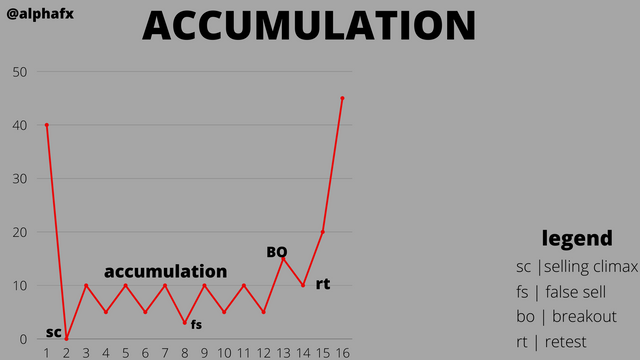.png)
During a downtrend, the market reaches a point it cannot sell below, this lowest point in price is the selling climax.
The first move of the composite man is to buy up stakes in that market. He does this after the market hits a selling climax subtly and over a very long period to avoid massive movement in the market. Price trades in a consolidation channel, bouncing off support and resistance and faking out once in a while.
This period is characterized by consolidation, but the footprints come in form of the high volume traded over this period. After he is done buying, he creates awareness, driving the price up.
Uptrend
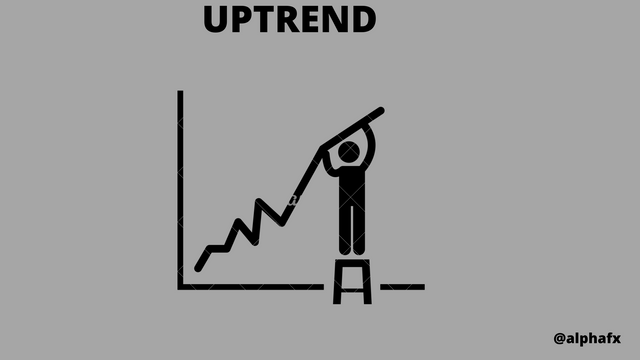.png)
We all know what an uptrend is. As soon as the market starts buying up, more people jump on the trend and the hype grows, demand increases to outweigh the supply. The price rockets till the buying power of the bulls start exhausting. This is marked by a point I'll call the buying climax. This point is when the Composite Man starts selling off slowly.
Distribution
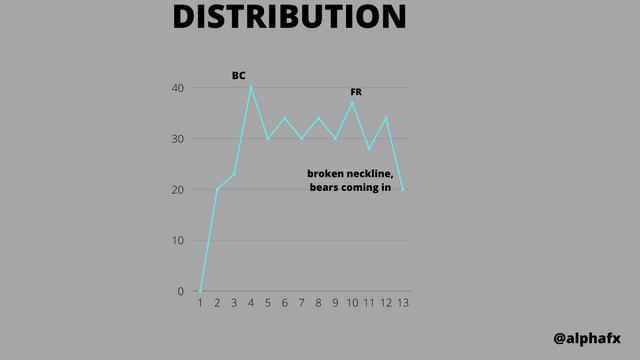.png)
The market hits a buying climax(BC) and the Composite man smiles now, he has made his profit, time to offload, but to avoid triggering a market crash, or a volume in transaction that raises suspicion, he starts selling off to the late buyers. at this point, there is a lot of buys too, but he is selling his massive portfolio and balancing the chart. this period is marked by high volume, yet no definite direction in movement. The market attempts to rally at some point, but fails, and with time, breaks support to show the incoming downtrend.
Downtrend
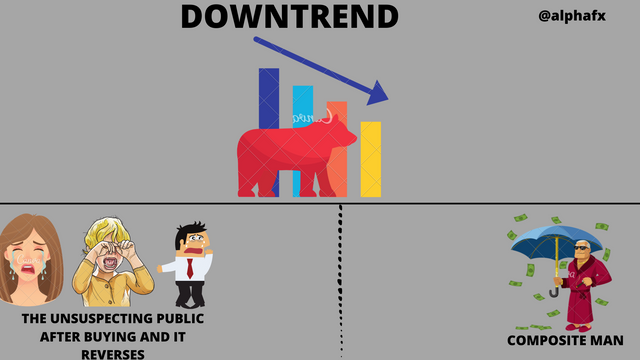.png)
The Composite man is done selling, market loses its strength and trades in a channel, regularly testing support and resistance. It breaks the support, showing first signs of weakness, then revisits the BC level before finally losing it and supply overcomes demand trigerring the price fall. During the downtrend the market will try to buy periodically,, a bull-trap. The sell continues and a lot of late investors or late sellers lose money. The downtrend lasts for a while and then hits a new selling climax and the accumulation phase kicks-off the new cycle again.
Personal View
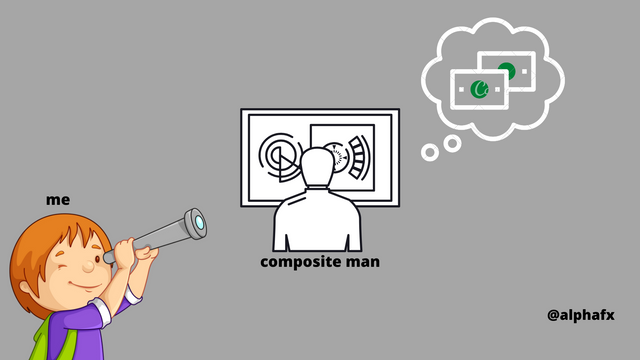.png)
However, real sense, the Composite Man is usually most likely a coordinated group of well-funded investors/traders than an actual person. What they do is "unfair", and pump and dumps, just at a larger scale. Again, I consider the fact that they have risked a lot of capital too. If they lost it due to some fundamental they had no control of (e.g Covid-19 markets dump 2020), they would bear the pain alone too.
Be that as it may, it is a very manipulative move, and this leaves a lot of late buyers with losses/worthless commodities in their hands, while the elites smile. People should learn how to spot a move by the composite man, becasue no matter how sleek his moves are, you are sure to see his footprints on the chart. This is usually represented when there is high volume but low volatility.
Fundamental Laws
There are three laws proposed by Wyckoff to explain the correlation and the result of human behaviour and that of the market.The law of demand nd supply, the law of Effort vs Result, the law of Cause and Effect. Let's throw more light shall we?
Law of Demand and Supply
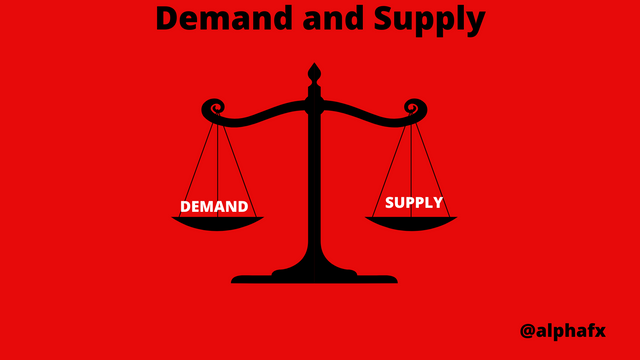.png)
This law is not exclusive to Wyckoff. It is a general law in economics. A lot of works refer to its principles. It basically compares the balance between supply and demand to changes in price. The law states that; a significant increase in demand leads to an increase in price and vice versa.
The volume of supply and demand is measured by volume bars and monitored by traders, to make trading decisions. The supply and demand law is one of the tools the composite man can manipulate because buying up a large percentage of the supply of the commodity reduces the available supply, and when the commodity comes into demand, prices drive up. When he sells off to the numerous buyers trying to get in, he increases the supply and once demand runs out, there is a significant drop in price.
Law of Cause and Effect
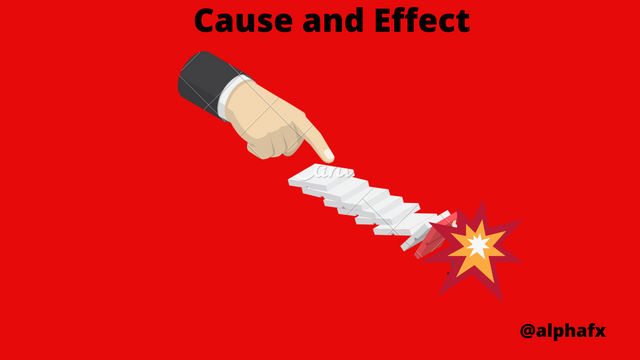.png)
This law was where Wyckoff explained how different factors trigger differences in supply and demand. In other words, this law complements the law of supply and demand. Wyckoff also proposed that effects are usually directly proportional to the causes. A small cause will produce a small effect and vice versa.
The Accumulation and Distribution phases are periods when Causes come and go, trying to break out the price, and as soon as the cause is big enough, the effect comes in form of an uptrend or downtrend.
Law of Effort and Result
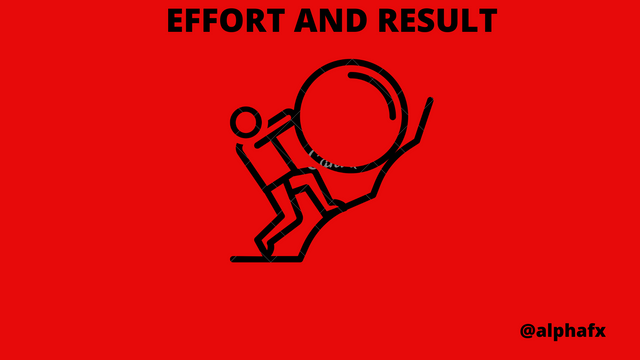.png)
Effort here can be said to be volume, and price action the result. When the resistance level of the accusation phase is broken, it shows effort and a resulting uptrend follows. This can be said for the support of the distribution phase and the resulting downtrend.
Sometimes we experience high volume, yet no significant change in price. This results in an abnormality in the relationship between volume and price, creating what we traders know as divergence.
WYCKOFF ANALYSIS ON DOGE

After the sell hits the climax there, we can see doge trade in a channel, with low but equal buy and sell volumes, a spike in volume brings about a breakout from the channel. a reaccumulation occurs in form of a penant flag which broke out upward as buying volume incased steadily. The bulls rode till the buying climax is hit,and the price dropped.
Market traded within that support and resistance at BC for some time before attempting a failed rally. Price retired and broke the neckline/support, and went on to how signs of weakness. after two retests of the neckline, the sell has continued, and will hit a new selling climax so that the accumulation phase can start again.
CONCLUSION
We should understand that while wyckoff proposed these theories, he also understood that deviation and variety is a determining factor, because the composite man would try to hide his tracks better each time, making the whole sequence differ sometimes in shape, and timing, but overall we can still expect the same result.
I thank @fendit for this very interesting topic. She has opened more eyes to the ways of the Composite Man and now we will not suffer from his antics, but rather learn to track him and make profits from that. Today the Composite man comes in form of Pumpand Dump groups on twitter and discord, rich elites trying to manipulate the markets, etc.

Thank you for being part of my lecture and completing the task!
My comments:
Hey, so good to see you here!!
Loved your work, it's so creative and ellaborate that has been a pleasure for me to read it! :)
As well as that, it's pretty clear that you know what you're talking about as your explanations are really interesting and precise.
Still, I wish I had seen a bit more development on the analysis of DOGE!
Thank you for being part of my class! :)
Overall score:
8/10
Downvoting a post can decrease pending rewards and make it less visible. Common reasons:
Submit